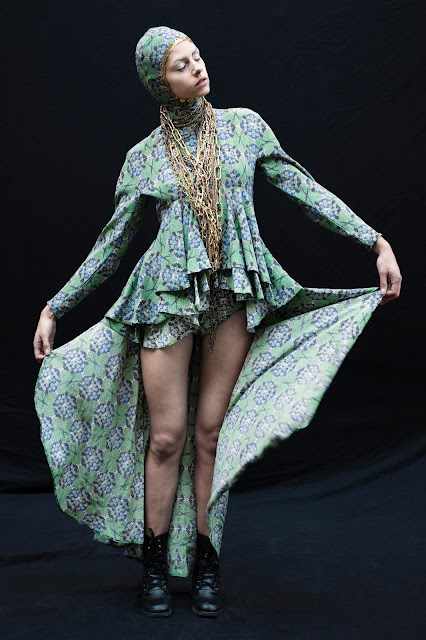Well into the third week
of April, Belgian sun finally decided to show her unreliable rays.
It got me thinking about
other more exotic countries, where the sun is a given and they don't even have
a word for 'rain coat' or 'umbrella'. (Come to think of it, in my rebellion
against Belgian rain, I never use either)
'Exotic' is used to
describe everything foreign, things that are not from 'here'. At the same time
it is used to embellish hidden insults, 'that's an exotic hairdo', meaning you
just hate it. A negative meaning to distance yourself from what you're seeing
(and you’re obviously not understanding).
Throughout history
people have looked at 'the other' in this way, completely putting these unknown
religions, races, life choices, rituals and habits apart from their own.
Taking fashion into the
equation, the concept of 'ethnic dress' is an entirely western construction.
Everything that strays from the traditional western mode of dress is by direct
result denominated 'ethnic'.
This perception is very
prominent in this Spanish take on an African Tribe costume. These
costumes are used in the Parada Moros y Cristianos all over Spain.
 |
Parada Moros y Cristianos, El Verger, 2009
I think it is very interesting how the African costume is interpreted by the Europeans. Animal skin, feathers, a spear, impressive face painting, all the clichés are present.
It was an assignment at the academy that got me to further research this costume. The exercise consisted in choosing and replicating an ethnic costume of choice.
After an extensive search for beads, feathers, leather etc. and engaging some friends and family to help me put together the spear and helmet. The final result was impressive!
|


In our western minds everything that strays from our modes of dress is considered ethnic.
This can be seen as strange as it is the western clothing that is exceptional in several ways.
For example, in 'ethnic clothing', patterns are often constructed from geometrical shapes like squares, circles and triangles. These patterns, sometimes made as one piece on a loom, often don't have to be cut or sewn but are draped around the body.
 |
Portrait of a Nair woman
This Sari, a traditional Indian dress, is worn
draped around the body.
It has a rectangular pattern.
|
Modern western dress, from the Middle Ages till now, has been predominantly sewn and tight round the body rather than draped.
Earlier, highly developed civilizations considered unsewn drapes to be the height of sophistication.
The ancient Romans for example were proud of their luxurious togas and citizens were even forbidden to wear fitted clothing. Sewn clothing was considered barbaric.
 |
| Marble Statue of August, Roman Emperor |
The reasons for this preference for uncut cloth are various. Fabric was very expensive and the ample consumption thereof was used to express wealth. It was also believed that fabric had not only a structural but a spiritual integrity. Clothing serves as a protection against external circumstances, like cold weather, but it is also believed it protects the wearer against all kinds of evils. That's way the cloth had to stay intact. If this isn't possible, the textile is cut in big geometrical shapes that are believed to be powerful.
That is also why embellishments on ethnic clothing are often found on important and vital parts of the body, like the heart, the head and the wrists. They serve as a talisman to fend off bad spirits and curses.
 |
The beads and embroideries on the dress and
headdress of this Nordic bride are most dominant
on the chest and head area.
|
Our western conception that draped dress or clothing made of simple geometrical pieces of fabric is less refined, because easier to make, is a misguided opinion. Most of the time so called 'ethnic' costumes are much closer and in keeping with our human needs and nature.
So we can ask ourselves: isn't our fleeting modern fashion, which changes with the seasons and whims of designers, the exotic oddball?



















